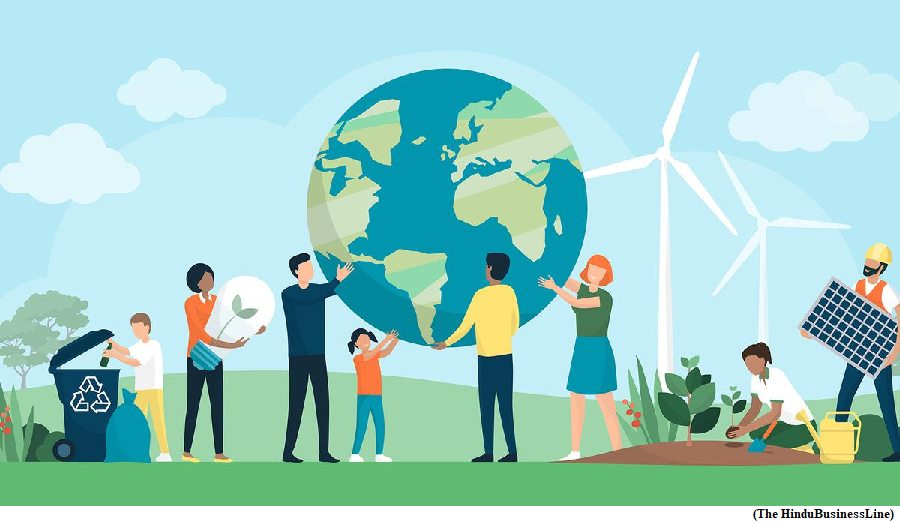Budget 2023: A mixed bag for climate action (GS Paper 3, Economy)

Context:
- Green growth features prominently among the key priorities listed in the 2023 Union Budget.
- Achieving this objective will require not only powering future growth through clean energy technologies but also addressing the now inevitable impacts of climate change on India’s developmental agenda.
Outlay:
- Within this theme, Finance Minister announced a slew of measures for accelerating the energy transition. A capital outlay of INR 35,000 crores was announced for the energy transitions under the Ministry of Petroleum and Natural Gas.
- The breakup of the Ministry’s budget does not list any new or specific allocations clearly related to clean energy.
- The INR 20,700 crore allocation to evacuate and integrate 13 GW of renewable energy (RE) from Ladakh is also an important step to utilise the untapped RE potential of the state and could provide a boost to the economic development in the region.
Green Hydrogen Mission:
- Perhaps, the biggest push on green energy is the promised outlay of INR 19,700 crores for the recently launched Green Hydrogen Mission.
- Green hydrogen is expected to be a critical future fuel for decarbonising harder-to-abate industrial and transport segments and the mission is a strong statement of India’s intent to be a leader in this space.
- Although the allocation to the mission in this fiscal year is only INR 297 crores, we can expect greater outlays going forward, ideally with a specific focus on creating demand from specific industries and R&D and capital support to indigenise the supply chain for producing hydrogen.
EVs:
- Battery storage, a critical missing piece in the transition to greater utilisation of renewable energy, is also given a boost with the announcement of viability gap funding for storage projects with capacity of 4,000 MWH.
- Electric vehicles, rail-based transport, green urbanisation, and circular economy also appear to be some of the other key focus areas for the government.
- The removal of custom duties on components needed for manufacturing lithium-ion batteries could help reduce the cost of electric vehicles, setting the stage for greater adoption.
Biomass:
- The GOBARdhan scheme with the aim to setup 200 biogas plants is an important step to encourage a circular economy, but more needs to be done to push for circularity for recycling plastics and critical minerals from batteries and solar panels.
Perspective of climate adaptation:
- India is expected to be among the countries worst affected by climate change.
- In 2022, India recorded extreme weather events such as heatwaves, floods, and cyclones on 88 percent of the days. These extreme events lead to loss of lives and livelihoods and threaten to wipe out many of the developmental gains made in the last three decades.
- Thus, it is imperative that India focuses on measures that build resilience amongst vulnerable communities to withstand these changes.
- This will require investment in physical capital to deal with the immediate consequence of climate-related extreme events and human and social capital to provide alternate climate-resilient livelihoods.
National Adaptation Fund
Localised efforts:
- While many adaptation actions must be localised and implemented by states, budgetary support from the Centre is crucial to provide cash-strapped states resources to implement these projects and the lack of focus on this Fund does not bode well for the future.
- Aside from specific funding, many resilience-building measures are also funded from the budget for other development programmes implemented by different ministries.
- The massive 18 percent decline for the MNREGA scheme will have substantial impact on adaptation efforts in addition to the loss of rural livelihoods. Much of the works carried out under the programme have a direct impact on reducing vulnerability to climate hazards including drought proofing , water conservation, and land development.
- The programme has played a key role in building climate smart villages but the current budget allocation seems to ignore these co-benefits.
- The lack of increases in the budget for many other programmes will also have impact on adaptation efforts including the Crop Insurance Scheme, Krishi Unnati Scheme, Green India Mission, among others.
Bright perspectives:
- The 63 percent increase in the PM-Awas Yojana could have a positive effect if the implementation focuses specifically on location relevant climate resilient housing in rural areas.
- The Mangrove Initiative for Shoreline Habitats & Tangible Income (MISHTI) could also help improve the resilience of certain areas prone to cyclones and storm surges given that mangroves act as a natural barrier against these extreme events.
- The net effect of these mosaics of intervention on building climate resilience across the country is difficult to ascertain.
Way Forward:
- Going forward, there is a clear imperative to implement a system for climate budgeting that can allow for a clearer understanding of the net allocations which are relevant to climate adaptation efforts. Such a system will be crucial for directing resources for most relevant adaptation actions.
- Overall, the Union Government has once again shown its clear commitment to the energy transition. Going forward, more needs to be done to mainstream climate adaptation efforts into the budgeting process.


